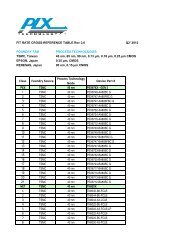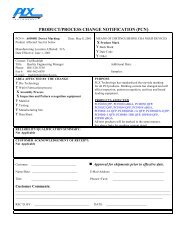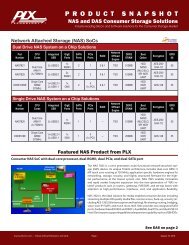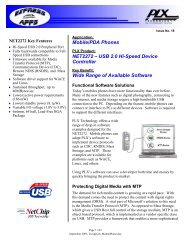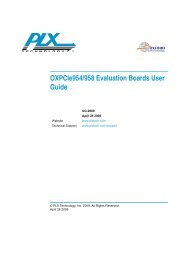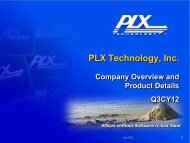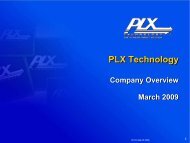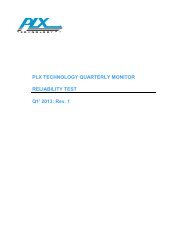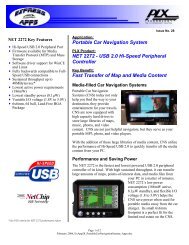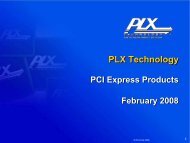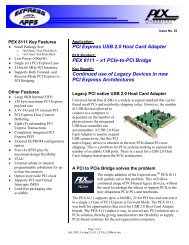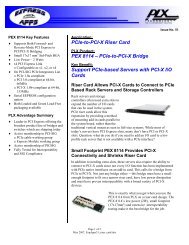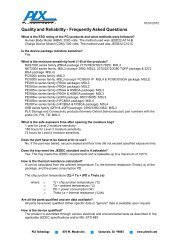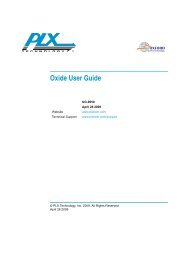the 2009 Annual Report (pdf) - PLX Technology
the 2009 Annual Report (pdf) - PLX Technology
the 2009 Annual Report (pdf) - PLX Technology
You also want an ePaper? Increase the reach of your titles
YUMPU automatically turns print PDFs into web optimized ePapers that Google loves.
2. Share-Based Compensation<br />
Stock Option Plans<br />
In May 2008, <strong>the</strong> Company’s stockholders approved <strong>the</strong> 2008 Equity Incentive Plan (“2008 Plan”). Under <strong>the</strong><br />
2008 Plan, <strong>the</strong>re is authorized for issuance and available for awards an aggregate of 1,200,000 shares of <strong>the</strong><br />
Company’s common stock, plus <strong>the</strong> number of shares of <strong>the</strong> Company’s common stock available for issuance under<br />
<strong>the</strong> Company’s prior incentive plan, its 1999 Stock Incentive Plan, that are not subject to outstanding awards as of<br />
May 27, 2008. In addition, <strong>the</strong> share reserve under <strong>the</strong> 2008 Plan will be increased by <strong>the</strong> number of shares issuable<br />
pursuant to awards outstanding under <strong>the</strong> prior plan that would have o<strong>the</strong>rwise reverted to <strong>the</strong> prior plan because it<br />
expires, are canceled or o<strong>the</strong>rwise terminated without being exercised. Awards under <strong>the</strong> 2008 Plan may include<br />
stock options, restricted stock, stock appreciation rights, performance awards, restricted stock units and o<strong>the</strong>r awards,<br />
provided that with respect to full value awards, such as restricted stock or restricted stock units, no more than 300,000<br />
shares may be issued in <strong>the</strong> form of full value awards during <strong>the</strong> term of <strong>the</strong> 2008 Plan. Awards under <strong>the</strong> 2008 Plan<br />
may be made to <strong>the</strong> Company’s officers and o<strong>the</strong>r employees, its board members and consultants that it hires and<br />
have a term of seven years. The 2008 Plan has a term of ten years.<br />
Share-Based Compensation Expense<br />
The fair value of share-based awards to employees is calculated using <strong>the</strong> Black-Scholes option pricing model,<br />
which requires subjective assumptions, including future stock price volatility and expected time to exercise, which<br />
greatly affect <strong>the</strong> calculated values.<br />
The weighted-average fair value of share-based compensation to employees is based on <strong>the</strong> multiple option<br />
valuation approach. Forfeitures are estimated and it is assumed no dividends will be declared. The estimated fair<br />
value of share-based compensation awards to employees is amortized using <strong>the</strong> straight-line method over <strong>the</strong> vesting<br />
period of <strong>the</strong> options. The weighted-average fair value calculations are based on <strong>the</strong> following average assumptions:<br />
Years Ended December 31,<br />
<strong>2009</strong> 2008 2007<br />
Volatility…………………………………………… 0.62 0.54 0.59<br />
Expected term of options (in years)……………… 4.51 4.47 4.35<br />
Risk-free interest rate……………………………… 2.34% 2.55% 4.31%<br />
Risk-Free Interest Rate. The risk-free interest rate is based on <strong>the</strong> U.S. Treasury yield curve in effect at <strong>the</strong> time of<br />
grant for <strong>the</strong> expected term of <strong>the</strong> option.<br />
Expected Term. The Company’s expected term represents <strong>the</strong> weighted-average period that <strong>the</strong> Company’s stock<br />
options are expected to be outstanding. The expected term is based on <strong>the</strong> observed and expected time to post-vesting<br />
exercise of options by employees. The Company uses historical exercise patterns of previously granted options in<br />
relation to stock price movements to derive an employee behavioral pattern used to forecast expected exercise<br />
patterns.<br />
Expected Volatility. The Company has historically calculated its expected volatility assumption required in <strong>the</strong><br />
Black-Scholes model by blending <strong>the</strong> historical and implied volatility. The historical volatility is based on <strong>the</strong> weekly<br />
closing prices of its common stock over a period equal to <strong>the</strong> expected term of <strong>the</strong> option. Market based implied<br />
volatility is based on utilizing market data of actively traded options on <strong>the</strong> Company’s stock, from options at- or<br />
near-<strong>the</strong>-money traded options, at a point in time as close to <strong>the</strong> grant of <strong>the</strong> employee options as reasonably practical<br />
and with similar terms to <strong>the</strong> employee share option, or a remaining maturity of at least six months if no similar terms<br />
are available. The historical volatility of <strong>the</strong> price of <strong>the</strong> Company’s common stock over <strong>the</strong> expected term of <strong>the</strong><br />
option is a strong indicator of <strong>the</strong> expected future volatility. In addition, implied volatility takes into consideration<br />
market expectations of how future volatility will differ from historical volatility. Historically, <strong>the</strong> Company did not<br />
believe that one estimate was more reliable than <strong>the</strong> o<strong>the</strong>r so it used a 50/50 blend of historical volatility and marketbased<br />
volatility. However, due to <strong>the</strong> recent lack of available market data to calculate implied volatility, <strong>the</strong> Company<br />
began using 100% historical volatility during <strong>the</strong> fourth quarter of 2008.<br />
49




